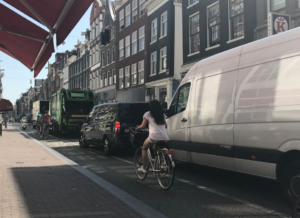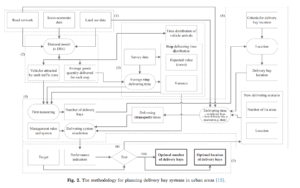Availability of loading and unloading zones is critical for reducing urban transport times and costs of last mile operations, improving planning, as well as for improving city sustainability, road safety, and livability. After defining the appropriate number and location of such bays, urban sustainability and liveability can be improved with telematics tools which enable real-time bay reservation and monitoring, integrating such information within transport management solutions.
Planning loading and unloading zones
A research paper by the Department of Enterprise Engineering, University of Rome Tor Vergata, presents an architecture for such tools along with methodology integrating delivery bay planning with transportation demand modeling through simulation, allowing computation of performance indicators to be used for ex-ante assessment in planning delivery scenarios. The results were validated through a simulation-based approach to Rome’s limited traffic zone.
The proposed methodology to support the planning and management of delivery schemes within urban areas and presented a scenario analysis using a discrete event simulation approach. In addition, a prototype tool to support transport and logistics operators delivering in an urban area was also presented. The proposed planning methodology deals with the randomness of vehicle arrivals and delivery times. In a real test case, future scenarios were simulated, and its performances were compared with a base one.
Results
The future delivery schemes showed that vehicles approaching the inner city area of Rome can actually benefit from suggestions on which delivery bay to use according to their trip characteristics, and from booking a delivery bay in advance.
Preliminary results confirm the goodness of the proposed methodological framework and, at the same time, demonstrate that in those areas where little space is available for such operations, the ameliorative margins of management and control of loading and unloading zones can be significant.
Future research
The tools in question could also be further improved: the size of loading and unloading zones provided could be calibrated according to the length of vehicles. Further, the tour search engine could be extended implementing a rich vehicle routing and scheduling modules. The performance of such a system with ad-hoc waiting spaces could then be compared with systems that consider delivery tours. Finally, recent ITS developments and implementation within a citywide ITS platform could supply personalized and predictive information (travel times), taking into account real-time road network states.
Finally, future developments will also focus on improving the models (through a more extensive survey) and overcoming the assumptions introduced in the planning phase, such as simulating a new delivery scheme that permits prior booking with suggestions on delivery tours. With respect to the management and control phase, future research will investigate the calibration of individual tour utility models and the learning process, and test the instruments providing real-time suggestions to transport and logistics operators. Such tools may constitute effective support both to transport and logistics operators, and city administrators as well. While the time spent on freight operations as well as delivery costs can be reduced, from the city administrators’ perspective this research can provide the right number of delivery bays and hence reduce interference with other city mobility components, thereby improving city sustainability and liveability.
Source: Comi, A., et.al. (2018). Smart urban freight transport: tools for planning and optimising delivery operations. Simulation Modelling Practice and Theory. 88 – November 2018, Pages 48-61


